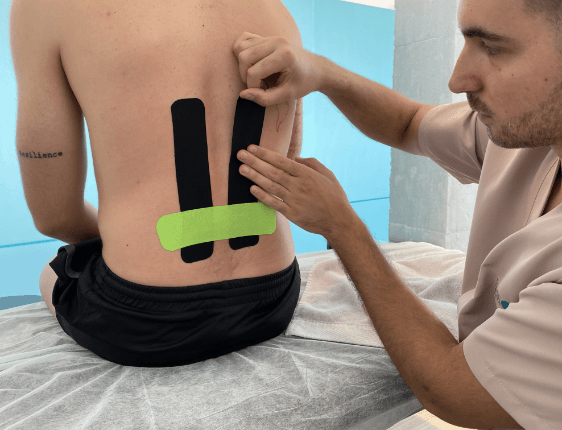
Técnica japonesa que actúa sobre el sistema musculoesquelético y linfático
El kinesiotaping o vendaje neuromuscular es una técnica japonesa de vendaje que actúa sobre el sistema musculoesquelético y linfático. La desarrolló el Dr. Kenzo Kase y consiste en aplicar sobre la parte dolorida unas vendas adhesivas que se adaptan por ser elásticas como la propia piel. Seguro que las has visto alguna vez en la calle y te has preguntado: ¿para qué sirven? Sigue leyendo, te contamos todo.
Gracias a las características de la venda permiten el movimiento de la zona vendada, a diferencia de los vendajes clásicos. El kinesiotaping es muy útil contra el dolor y las lesiones musculares, tal y como diversos deportistas y pacientes han manifestado tras probarla durante un tiempo.
Comenzó utilizado por ortopedistas, quiroprácticos, acupunturistas y otros profesionales de Japón; hoy día se ha extendido a todo el mundo gracias a los casos de éxito que se han dado en el mundo del deporte; numerosos atletas que han explicado cómo el vendaje neuromuscular ha cambiado, de una forma u otra, su rendimiento deportivo.
A description of neuromuscular bandage.
The tape is usually made of an elastic cotton bandage that can be stretched up to 140% of its original length. This tape, as has been demonstrated in practice, successfully corrects the alignment of weak muscles and facilitates joint movement, thanks to the traction qualities of the bandage itself.
This tape must be applied over the stretching muscle, from the origin point of the muscle to its point of insertion. Once applied, the tape is then rubbed, in order to activate the adhesive.
Neuromuscular tape is typically applied in three general shapes: the “I” shape, for small or linear places; the “Y” shape, for larger muscles such as the deltoid; and the “X” shape, for large and long muscles, such as the quadriceps.
Its analgesic properties are also being studied: according to what we have experienced with some of our patients, neuromuscular taping may help reduce inflammation and optimize mobility. This will provide the patient with greater performance and stability when practicing sports and in their daily routines.

Neuromuscular Taping Success Stories: From Armstrong to Serena Williams
Neuromuscular taping, an elastic bandage used to treat various dysfunctions, gained wide popularity at the 2008 Beijing Olympics. Kerri Walsh was one of the athletes to appear with the tape in competition, but not the only one. Lance Armstrong, for his part, has repeatedly described the numerous benefits of neuromuscular taping. Other athletes, such as Serena Williams, Buffon, Mario Ballotelli, and Djokovic, have expressed their satisfaction with the results of this type of bandage.
One of the best known cases is that of WWE wrestler John Cena, who used the tape to reduce pain and eliminate inflammation after undergoing an operation to remove bone chips from his elbow.
Indications for neuromuscular taping:
- Reduce inflammation
- Pain relief
- Reduce bruising
- Joint correction
- Improved proprioception
- Fascia correction
- Stimulation of hypotonic muscles
- Inhibition of hypertonic muscles


